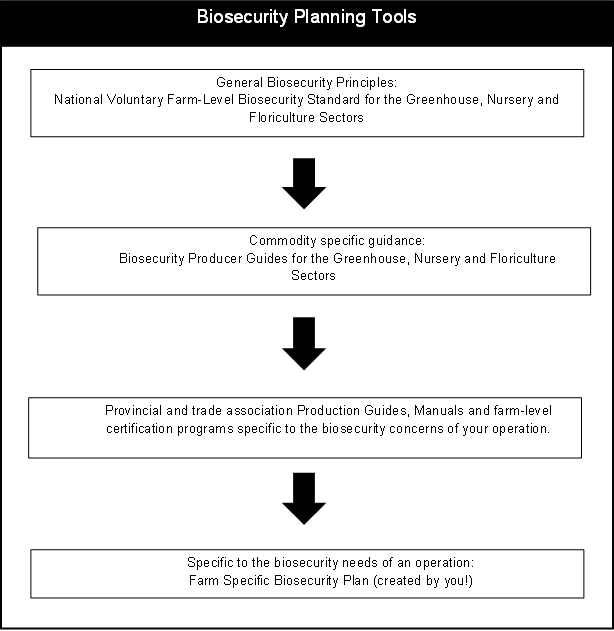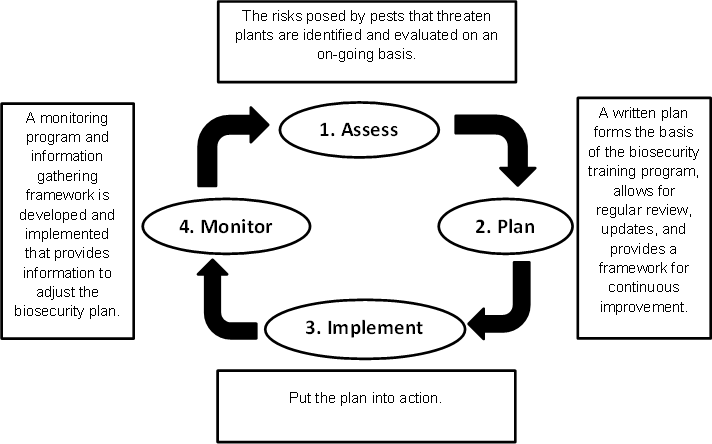National Voluntary Farm-Level Biosecurity Standard for the Greenhouse, Nursery and Floriculture Sectors
1.0 Introduction
This page is part of the Guidance Document Repository (GDR).
Looking for related documents?
Search for related documents in the Guidance Document Repository
1.1 What is Farm-Level Greenhouse, Nursery and Floriculture Biosecurity? Why is it important? Who is responsible?
Biosecurity refers to a series of management practices designed to prevent, minimize and manage the introduction, spread, and release of plant pests. This includes pests not established in Canada, pests established in limited areas of Canada, and pests widely distributed that can spread from farm to farm. The implementation of farm-level biosecurity in Canada protects our environment, viability of the agricultural sector and supports our reputation as a safe and reliable trading nation. This has significant economic, environmental and community benefits for all Canadians.
The Canadian Food Inspection Agency (CFIA) works with stakeholders to develop national voluntary farm-level biosecurity standards and producer guidance documents for several crop and animal-based sectors. The development process is supported by Agriculture and Agri-Food Canada (AAFC) under the Growing Forward 2 Agricultural Policy Framework. In order to ensure that what is developed is relevant and useful for producers and the sector as a whole, Biosecurity Advisory Committees (BACs) have been developed which pull together expertise from sector and producer organizations, producers, academia, and federal and provincial specialists. See Appendix 4 for partnership acknowledgments.
Using the North American Industry Classification System (NAICS) the Greenhouse, Nursery and Floriculture Industry Group has been deemed as one of the priorities for biosecurity standard development. Examples of these sectors are described by NAICS and include the following:
- Food crops grown under cover for example: fruit, berryFootnote 1, herb and spice or vegetable food crops grown in greenhouses or under cover. The biosecurity guidance provided in this document may also be applicable to other structures that do not meet the criteria of the greenhouse definition as provided by the glossary, such as hoop houses, shade houses or high tunnels;
- Establishments primarily engaged in growing nursery products, trees and short rotation woody crops that have a typical growth cycle of less than ten years, for example: field nurseries, fruit stock, ornamental plants, shrubs and trees that are nursery grown, and tree and shrub farming on short rotation;
- Establishments primarily engaged in growing, in greenhouses or in open fields, floriculture products and propagating materials, for example: floriculture, flower farming, flower seed production, production of cuttings for propagation, flower plant and bulb growing, cut or potted flowers, tropical foliage and green plants that are greenhouse grown;Footnote 2
- Mushroom and turf sod production are not included in this reference document.
Based on Statistics Canada information from 2011, the Greenhouse, Nursery and Floriculture (GNF) sector in Canada represents 7% (7,800) of all crop farms in Canada, and 4% of all farms, including animal production. Statistics Canada information from 2014 indicates that according to farm cash receipts, the GNF sectors account for 10% ($3 billion) of all crop farms in Canada and 5% of all farms. These sectors also represent about 25% (76,285) of all employees in agriculture. In addition, the GNF sector accounts for 26% ($1 billion) of horticulture exports. As such, the GNF sectors are critical for agricultural revenues, and especially for employment and incomes. All Canadians benefit from the economic linkages between the GNF sectors and other economic sectors in Canada.
There are differences within the greenhouse, nursery and floriculture sectors in terms of species produced, potential for pest introduction, region, climate, and production practices. Growers use a range of production systems which come with varying degrees of risk, for example, field soil, growing media or a complete hydroponic system. However, it is recognized that regardless of some production differences, the implementation of proactive biosecurity measures can mitigate the potential for introduction and spread of pests when applied at critical points in the cycle of transmission.
The National Voluntary Farm-Level Biosecurity Standard for the Greenhouse, Nursery and Floriculture Sectors(subsequently referred to as the "Standard") identifies key risks, target outcomes, considerations, and critical points of biosecurity interventions, based on pest introduction and transmission pathways. The level of risk for any given place of production will vary based on several factors. These factors may include but are not limited to; plant produced, potential for introduction, region, climate, and production practices. The implementation of proactive biosecurity measures can mitigate the potential for introduction and spread of pests if applied to break the cycle of transmission. Considerations as to why someone may want to implement biosecurity measures within an operation include:
- Business objectives in order to maintain markets;
- Customer demand for biosecurity practices and protocols;
- Decreased production losses;
- Avoiding the introduction of pests that are currently not present;
- The desire to contain and minimize pests that are already present;
- Responsibilities to neighbours and industry to ensure that biosecurity risks are not introduced to someone else.
Proactive biosecurity at the place of production is only one level of biosecurity. Beyond those plant health related activities that occur at the place of production, there is the need for broader education and outreach from retailers to the consumer level to protect plant health in Canada. Biosecurity is the responsibility of everyone. It is recommended that anyone responsible for the health of plants from small farms, to large facilities, consider developing a written biosecurity plan. Measures built into everyday management practices will go a long way toward protecting a place of production from the costly consequences of pests.
Industry and provincial and federal government agencies have worked in collaboration to develop and implement a variety of farm-level certification programs. The framework of the standard builds upon these strengths, and provides a national farm-level biosecurity standard for the GNF sectors. The standard provides guidance for the development of individual farm biosecurity plans or to enhance but not supersede existing farm level programs, such as CanadaGAP™ and other regional or provincial programs. Figure 1 shows how the documents and tools referenced in this standard support the development of farm-specific biosecurity plans.
Figure 1: A visual representation of how the various documents and tools referenced in this standard work together to help in the development of a farm specific biosecurity plan

Description for Figure 1: A visual representation of how the various documents and tools referenced in this standard work together to help in the development of a farm specific biosecurity plan
Development of your biosecurity plan for your farm should start with the general biosecurity principles of the National Voluntary Farm-Level Biosecurity Standard for the Greenhouse, Nursery and Floriculture Sectors. Then commodity specific guidance from the Biosecurity Producer Guides for the Greenhouse, Nursery and Floriculture Sectors and provincial and trade association production guides, manuals and farm-level certification programs that are specific to the biosecurity concerns of your operation should be considered. This will help you address and include the specific biosecurity needs of your operation in your farm specific biosecurity plan.
1.2 Elements of a Biosecurity Plan
The implementation of biosecurity principles in a place of production can be seen as a continuum of activities. Figure 2 provides a visual representation of the cycle of biosecurity activities, where the need to assess and re-assess can be seen as both the starting point of the cycle as well as the activity that continues the cycle. The practice of creating a biosecurity plan is a preventative approach to manage pest risk within the place of production. By assessing and re-assessing pest risk on a regular basis, continuous improvement can be achieved and activities which were once reactive, become measured and predictable.
Figure 2: Cycle of biosecurity activities

Description for Figure 2: Cycle of biosecurity activities
Figure 2 is an illustration of the cycle of activities that should be completed to develop and implement a biosecurity plan. The cycle of biosecurity activities has four items in the centre with arrows pointing between them in clockwise direction. The first item at the top of the cycle is Assess. Moving clockwise, the second item is Plan, the third item is Implement and the fourth item is Monitor. There is a text box by each of these items in the cycle (four in total). Above the word Assess there is a box with the following text: The risks posed by pests that threaten plants are identified and evaluated on an on-going basis. To the right of the word Plan there is a box with the following text inside: A written plan forms the basis of the biosecurity training program, allows for regular review, updates, and provides a framework for continuous improvement. Below the word Implement is a text box with the following text inside: Put the plan into action. To the left of the word Monitor is a text box with the following text: A monitoring program and information gathering framework is developed and implemented that provides information to adjust the biosecurity plan.
- Assess: Identify and evaluate the risks of pest introduction and analyze their pathways of transmission. This will allow for current biosecurity gaps within a place of production to be addressed. Production practices should be reviewed frequently (re-assess) to ensure that implemented measures are effective in relation to pest prevention and control.
- Plan: A written biosecurity plan is highly recommended. A written plan allows for regular review and update, facilitates continuous improvement within the place of production, and forms the basis for training. Note: the self-assessment tool (Appendix 1) provides a framework or starting point for the development of a biosecurity plan.
- Implement: Put the plan into action. Education, training and communication are key to implementing a biosecurity plan.
- Monitor: A monitoring program is developed and implemented for early detection, identification and ongoing monitoring of pests. It is important that the design, effectiveness and implementation of a biosecurity plan be assessed not only on a routine basis but also when changes in farm practices or biosecurity threats occur.
1.3 The Organization of the Biosecurity Principles
For the purpose of this document the principles of biosecurity have been grouped into three general areas that are important to a biosecurity plan.
1) Plant Health Management
- Proactive measures to promote healthy plant growth and to mitigate pest occurrence (Best Management Practices, management of the crop environment and managing pest vectors);
- Measures to detect and quantify pests (monitoring); and
- Measures to respond to pests (standard operating procedures for commonly encountered pests or response planning for pests of greater concern, such as quarantine pests).
2) Farm Operational Management
- The location and layout of a place of production;
- Risks associated with the continuum of activities within the place of production;
- Risks associated with how people, tools and equipment are moved within a place of production;
- Risks associated with receiving inputs (propagation materials, growing media and irrigation water) into a place of production; and
- Risk of final products and waste leaving a place of production in the form of outputs.
3) Education, Training and Communication
- It is important to educate and inform, service providers and visitors regarding the importance of respecting the biosecurity measures of a place of production.
- Train employees on the biosecurity measures that are implemented within a place of production.
- Date modified: